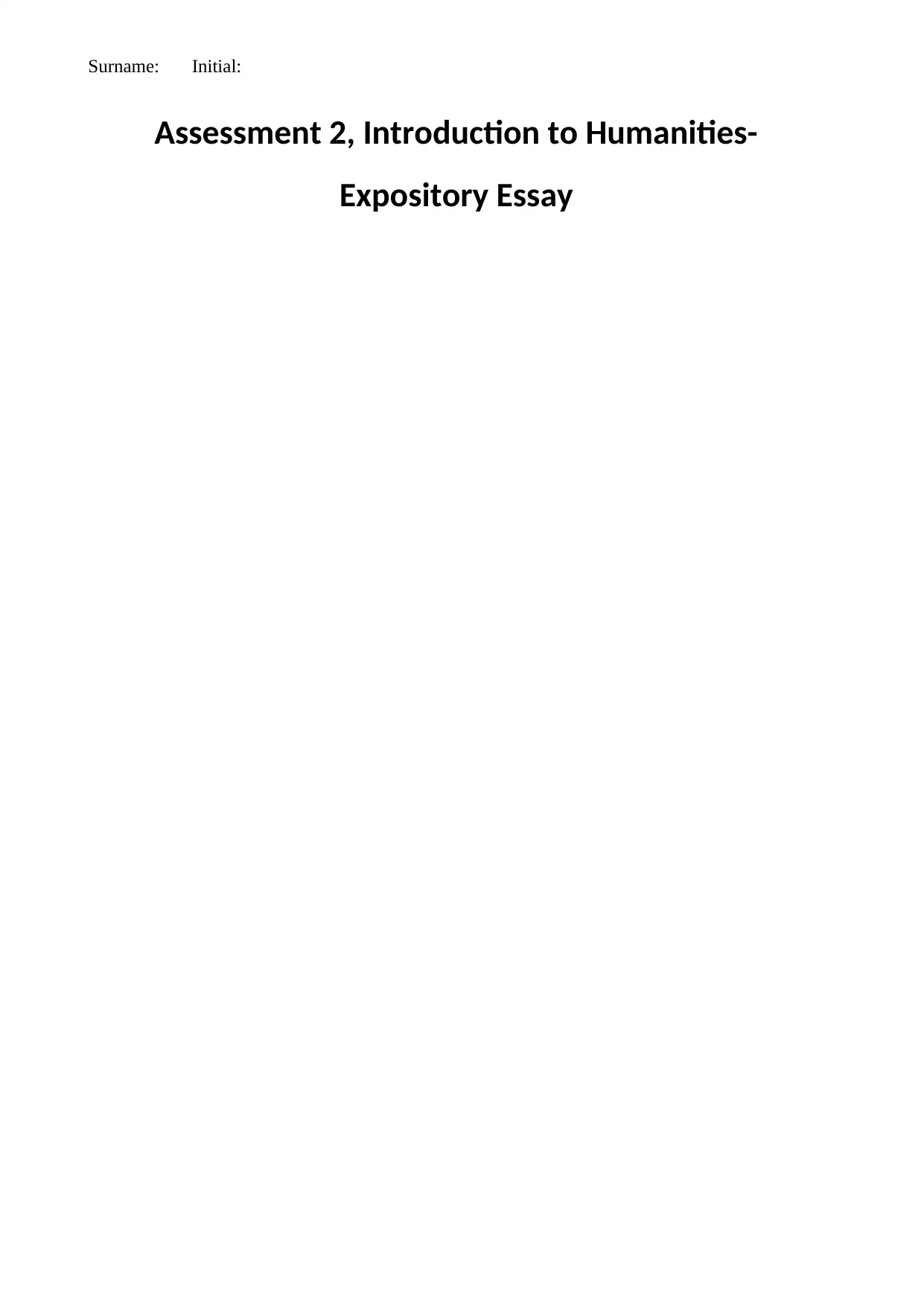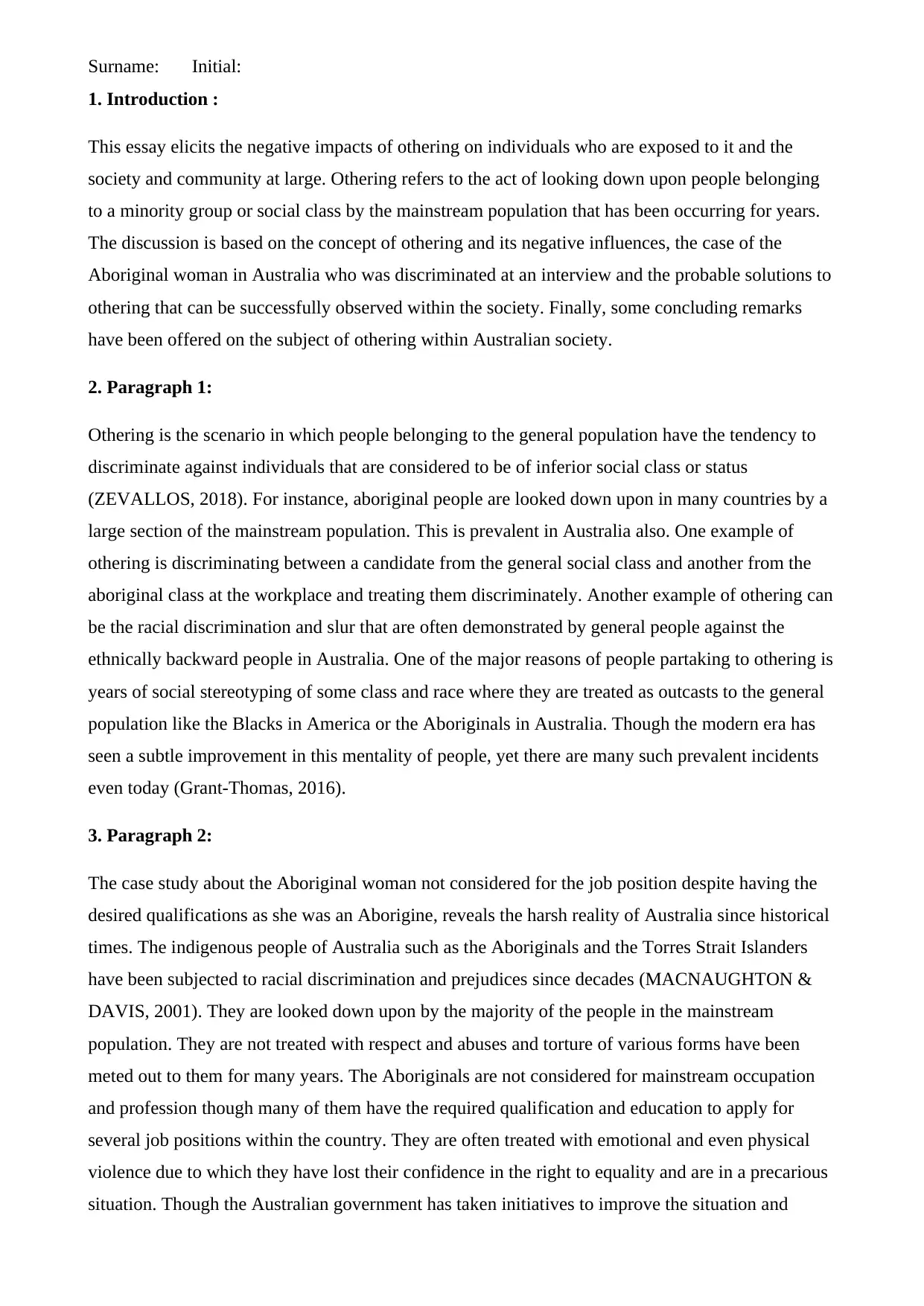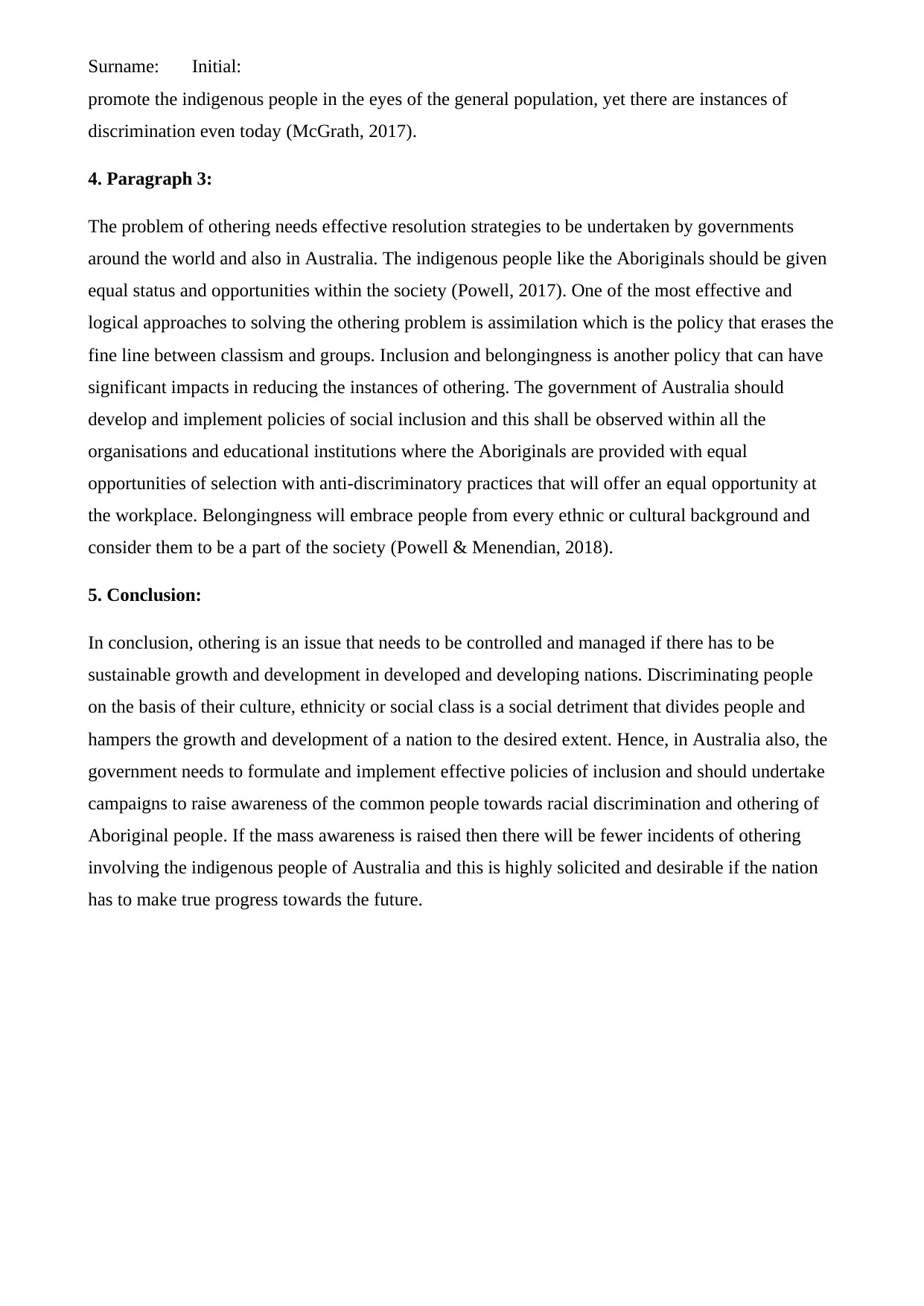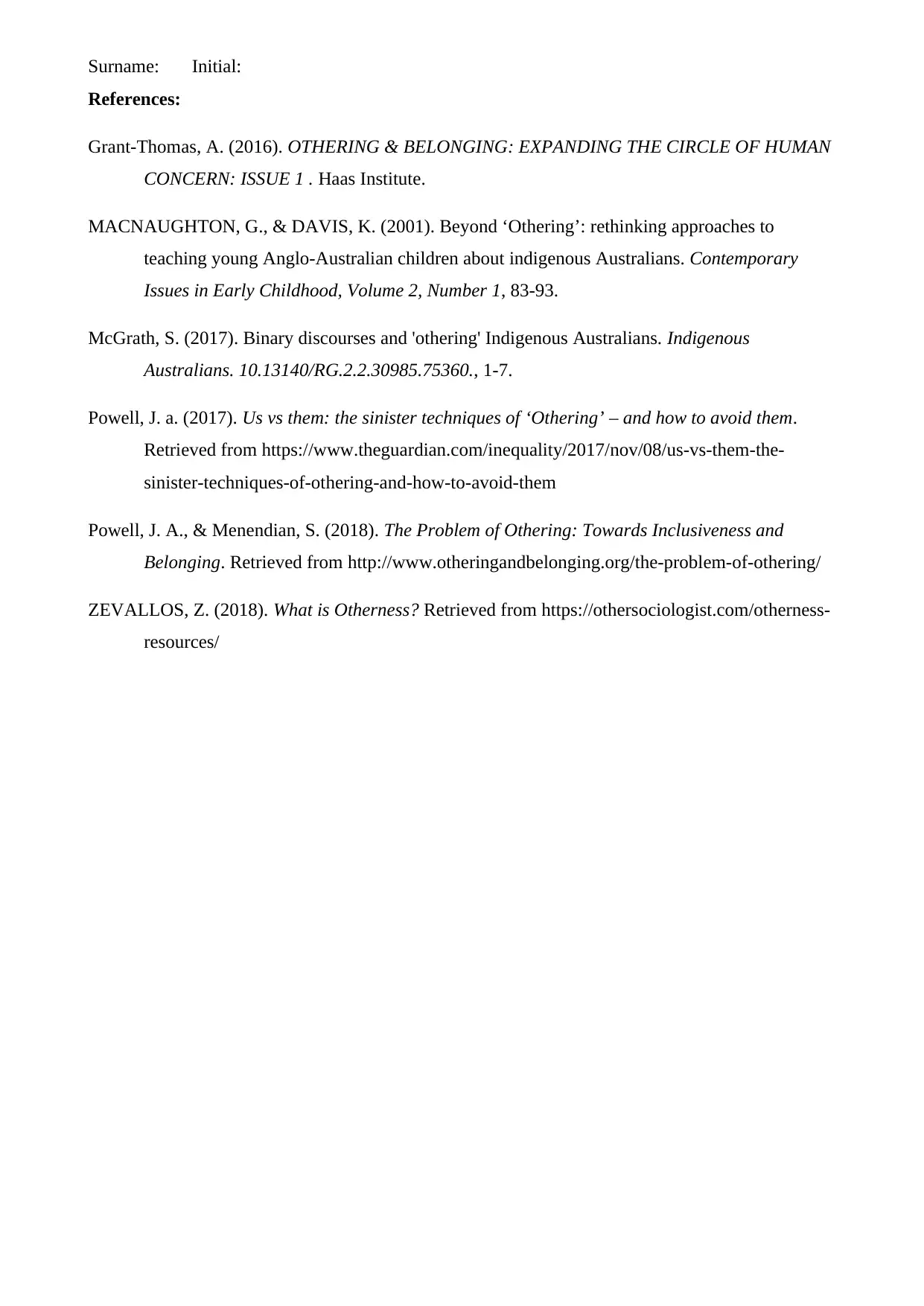Negative Impacts of Othering in Society: Humanities Essay, Australia
VerifiedAdded on 2019/10/18
|5
|1019
|214
Essay
AI Summary
This expository essay delves into the detrimental effects of othering on individuals and society, specifically examining the Australian context. The essay defines othering as the act of marginalizing minority groups, highlighting the discrimination faced by Aboriginal Australians in areas like employment. It presents a case study of an Aboriginal woman denied a job due to her ethnicity, illustrating the historical and ongoing challenges. The essay then proposes solutions such as assimilation, inclusion, and policies promoting equal opportunities to combat othering. The conclusion emphasizes the need for government intervention, social inclusion policies, and awareness campaigns to foster a more equitable and inclusive Australian society, promoting sustainable growth and development.

Surname: Initial:
NAME: __________________________
STUDENT ID# ______________________
NAME: __________________________
STUDENT ID# ______________________
Paraphrase This Document
Need a fresh take? Get an instant paraphrase of this document with our AI Paraphraser

Surname: Initial:
Assessment 2, Introduction to Humanities-
Expository Essay
Assessment 2, Introduction to Humanities-
Expository Essay

Surname: Initial:
1. Introduction :
This essay elicits the negative impacts of othering on individuals who are exposed to it and the
society and community at large. Othering refers to the act of looking down upon people belonging
to a minority group or social class by the mainstream population that has been occurring for years.
The discussion is based on the concept of othering and its negative influences, the case of the
Aboriginal woman in Australia who was discriminated at an interview and the probable solutions to
othering that can be successfully observed within the society. Finally, some concluding remarks
have been offered on the subject of othering within Australian society.
2. Paragraph 1:
Othering is the scenario in which people belonging to the general population have the tendency to
discriminate against individuals that are considered to be of inferior social class or status
(ZEVALLOS, 2018). For instance, aboriginal people are looked down upon in many countries by a
large section of the mainstream population. This is prevalent in Australia also. One example of
othering is discriminating between a candidate from the general social class and another from the
aboriginal class at the workplace and treating them discriminately. Another example of othering can
be the racial discrimination and slur that are often demonstrated by general people against the
ethnically backward people in Australia. One of the major reasons of people partaking to othering is
years of social stereotyping of some class and race where they are treated as outcasts to the general
population like the Blacks in America or the Aboriginals in Australia. Though the modern era has
seen a subtle improvement in this mentality of people, yet there are many such prevalent incidents
even today (Grant-Thomas, 2016).
3. Paragraph 2:
The case study about the Aboriginal woman not considered for the job position despite having the
desired qualifications as she was an Aborigine, reveals the harsh reality of Australia since historical
times. The indigenous people of Australia such as the Aboriginals and the Torres Strait Islanders
have been subjected to racial discrimination and prejudices since decades (MACNAUGHTON &
DAVIS, 2001). They are looked down upon by the majority of the people in the mainstream
population. They are not treated with respect and abuses and torture of various forms have been
meted out to them for many years. The Aboriginals are not considered for mainstream occupation
and profession though many of them have the required qualification and education to apply for
several job positions within the country. They are often treated with emotional and even physical
violence due to which they have lost their confidence in the right to equality and are in a precarious
situation. Though the Australian government has taken initiatives to improve the situation and
1. Introduction :
This essay elicits the negative impacts of othering on individuals who are exposed to it and the
society and community at large. Othering refers to the act of looking down upon people belonging
to a minority group or social class by the mainstream population that has been occurring for years.
The discussion is based on the concept of othering and its negative influences, the case of the
Aboriginal woman in Australia who was discriminated at an interview and the probable solutions to
othering that can be successfully observed within the society. Finally, some concluding remarks
have been offered on the subject of othering within Australian society.
2. Paragraph 1:
Othering is the scenario in which people belonging to the general population have the tendency to
discriminate against individuals that are considered to be of inferior social class or status
(ZEVALLOS, 2018). For instance, aboriginal people are looked down upon in many countries by a
large section of the mainstream population. This is prevalent in Australia also. One example of
othering is discriminating between a candidate from the general social class and another from the
aboriginal class at the workplace and treating them discriminately. Another example of othering can
be the racial discrimination and slur that are often demonstrated by general people against the
ethnically backward people in Australia. One of the major reasons of people partaking to othering is
years of social stereotyping of some class and race where they are treated as outcasts to the general
population like the Blacks in America or the Aboriginals in Australia. Though the modern era has
seen a subtle improvement in this mentality of people, yet there are many such prevalent incidents
even today (Grant-Thomas, 2016).
3. Paragraph 2:
The case study about the Aboriginal woman not considered for the job position despite having the
desired qualifications as she was an Aborigine, reveals the harsh reality of Australia since historical
times. The indigenous people of Australia such as the Aboriginals and the Torres Strait Islanders
have been subjected to racial discrimination and prejudices since decades (MACNAUGHTON &
DAVIS, 2001). They are looked down upon by the majority of the people in the mainstream
population. They are not treated with respect and abuses and torture of various forms have been
meted out to them for many years. The Aboriginals are not considered for mainstream occupation
and profession though many of them have the required qualification and education to apply for
several job positions within the country. They are often treated with emotional and even physical
violence due to which they have lost their confidence in the right to equality and are in a precarious
situation. Though the Australian government has taken initiatives to improve the situation and
⊘ This is a preview!⊘
Do you want full access?
Subscribe today to unlock all pages.

Trusted by 1+ million students worldwide

Surname: Initial:
promote the indigenous people in the eyes of the general population, yet there are instances of
discrimination even today (McGrath, 2017).
4. Paragraph 3:
The problem of othering needs effective resolution strategies to be undertaken by governments
around the world and also in Australia. The indigenous people like the Aboriginals should be given
equal status and opportunities within the society (Powell, 2017). One of the most effective and
logical approaches to solving the othering problem is assimilation which is the policy that erases the
fine line between classism and groups. Inclusion and belongingness is another policy that can have
significant impacts in reducing the instances of othering. The government of Australia should
develop and implement policies of social inclusion and this shall be observed within all the
organisations and educational institutions where the Aboriginals are provided with equal
opportunities of selection with anti-discriminatory practices that will offer an equal opportunity at
the workplace. Belongingness will embrace people from every ethnic or cultural background and
consider them to be a part of the society (Powell & Menendian, 2018).
5. Conclusion:
In conclusion, othering is an issue that needs to be controlled and managed if there has to be
sustainable growth and development in developed and developing nations. Discriminating people
on the basis of their culture, ethnicity or social class is a social detriment that divides people and
hampers the growth and development of a nation to the desired extent. Hence, in Australia also, the
government needs to formulate and implement effective policies of inclusion and should undertake
campaigns to raise awareness of the common people towards racial discrimination and othering of
Aboriginal people. If the mass awareness is raised then there will be fewer incidents of othering
involving the indigenous people of Australia and this is highly solicited and desirable if the nation
has to make true progress towards the future.
promote the indigenous people in the eyes of the general population, yet there are instances of
discrimination even today (McGrath, 2017).
4. Paragraph 3:
The problem of othering needs effective resolution strategies to be undertaken by governments
around the world and also in Australia. The indigenous people like the Aboriginals should be given
equal status and opportunities within the society (Powell, 2017). One of the most effective and
logical approaches to solving the othering problem is assimilation which is the policy that erases the
fine line between classism and groups. Inclusion and belongingness is another policy that can have
significant impacts in reducing the instances of othering. The government of Australia should
develop and implement policies of social inclusion and this shall be observed within all the
organisations and educational institutions where the Aboriginals are provided with equal
opportunities of selection with anti-discriminatory practices that will offer an equal opportunity at
the workplace. Belongingness will embrace people from every ethnic or cultural background and
consider them to be a part of the society (Powell & Menendian, 2018).
5. Conclusion:
In conclusion, othering is an issue that needs to be controlled and managed if there has to be
sustainable growth and development in developed and developing nations. Discriminating people
on the basis of their culture, ethnicity or social class is a social detriment that divides people and
hampers the growth and development of a nation to the desired extent. Hence, in Australia also, the
government needs to formulate and implement effective policies of inclusion and should undertake
campaigns to raise awareness of the common people towards racial discrimination and othering of
Aboriginal people. If the mass awareness is raised then there will be fewer incidents of othering
involving the indigenous people of Australia and this is highly solicited and desirable if the nation
has to make true progress towards the future.
Paraphrase This Document
Need a fresh take? Get an instant paraphrase of this document with our AI Paraphraser

Surname: Initial:
References:
Grant-Thomas, A. (2016). OTHERING & BELONGING: EXPANDING THE CIRCLE OF HUMAN
CONCERN: ISSUE 1 . Haas Institute.
MACNAUGHTON, G., & DAVIS, K. (2001). Beyond ‘Othering’: rethinking approaches to
teaching young Anglo-Australian children about indigenous Australians. Contemporary
Issues in Early Childhood, Volume 2, Number 1, 83-93.
McGrath, S. (2017). Binary discourses and 'othering' Indigenous Australians. Indigenous
Australians. 10.13140/RG.2.2.30985.75360., 1-7.
Powell, J. a. (2017). Us vs them: the sinister techniques of ‘Othering’ – and how to avoid them.
Retrieved from https://www.theguardian.com/inequality/2017/nov/08/us-vs-them-the-
sinister-techniques-of-othering-and-how-to-avoid-them
Powell, J. A., & Menendian, S. (2018). The Problem of Othering: Towards Inclusiveness and
Belonging. Retrieved from http://www.otheringandbelonging.org/the-problem-of-othering/
ZEVALLOS, Z. (2018). What is Otherness? Retrieved from https://othersociologist.com/otherness-
resources/
References:
Grant-Thomas, A. (2016). OTHERING & BELONGING: EXPANDING THE CIRCLE OF HUMAN
CONCERN: ISSUE 1 . Haas Institute.
MACNAUGHTON, G., & DAVIS, K. (2001). Beyond ‘Othering’: rethinking approaches to
teaching young Anglo-Australian children about indigenous Australians. Contemporary
Issues in Early Childhood, Volume 2, Number 1, 83-93.
McGrath, S. (2017). Binary discourses and 'othering' Indigenous Australians. Indigenous
Australians. 10.13140/RG.2.2.30985.75360., 1-7.
Powell, J. a. (2017). Us vs them: the sinister techniques of ‘Othering’ – and how to avoid them.
Retrieved from https://www.theguardian.com/inequality/2017/nov/08/us-vs-them-the-
sinister-techniques-of-othering-and-how-to-avoid-them
Powell, J. A., & Menendian, S. (2018). The Problem of Othering: Towards Inclusiveness and
Belonging. Retrieved from http://www.otheringandbelonging.org/the-problem-of-othering/
ZEVALLOS, Z. (2018). What is Otherness? Retrieved from https://othersociologist.com/otherness-
resources/
1 out of 5
Related Documents
Your All-in-One AI-Powered Toolkit for Academic Success.
+13062052269
info@desklib.com
Available 24*7 on WhatsApp / Email
![[object Object]](/_next/static/media/star-bottom.7253800d.svg)
Unlock your academic potential
Copyright © 2020–2025 A2Z Services. All Rights Reserved. Developed and managed by ZUCOL.





